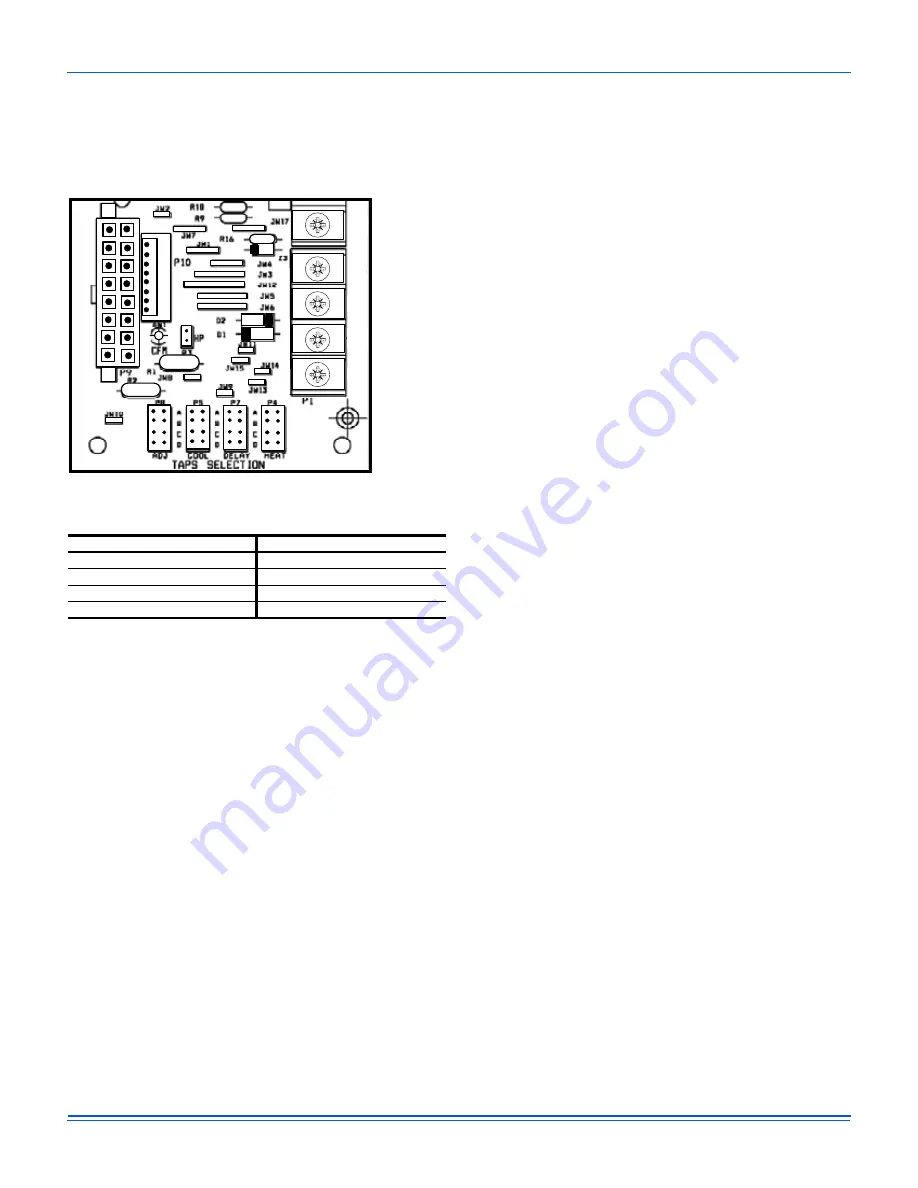
288591-BIM-C-0408
18
Johnson Controls Unitary Products
Fan Only CFM:
When the connection is made from “R” to “G”, the fan only
mode is activated. In this mode, the blower will deliver 75% of
the cooling system CFM. This connection is factory set from the
manufacturer and cannot be field adjusted.
Figure 10: Control Board Speed Tap Location
Operation
Cooling Sequence Of Operations
1.
If the fan switch on the thermostat is in the "ON" position, the
24 volts at "G" signals the ECM motor controller to operate
the blower at 75% of the rated airflow. If the fan switch on the
thermostat is in the "AUTO" position, the blower operates
only when there is a call for cooling by the thermostat.
2.
If the 2-stage thermostat calls for the first stage of cooling,
the 24 volts at "Y1" signals the ECM controller to operate the
blower at low speed and closes the contactor coil M1. Power
is supplied to the compressor and outdoor fan motor. When
the fan switch on the thermostat is in the "AUTO" position,
the indoor blower motor is energized at the low-speed
cooling airflow.
3.
If the 2-stage thermostat calls for the second stage of
cooling, the 24 volts at "Y2" signals the ECM controller to
operate the blower at high speed and energizes the
compressor solenoid to close the bypass ports so that the
compressor operates at full capacity. If the outdoor fan
motor has an ECM controller, the 24 volts at "Y2" signals
the motor to operate at high speed.
4.
When the cooling demand is satisfied, the 24 volt "Y1" and
"Y2" signals are removed and the M1 contactor is de-
energized. If the fan switch on the thermostat is in the "ON"
position, the blower will continue to run at 75% of the rated
airflow. If the fan switch is in the "AUTO" position, the
blower will continue to run for a short period as determined
by the "DELAY" jumper setting on the CFM Selector board.
Heating Sequence Of Operations
1.
If the fan switch on the thermostat is in the "ON" position, the
24 volts at "G" signals the ECM motor controller to operate
the blower at 75% of the rated airflow. If the fan switch on the
thermostat is in the "AUTO" position, the blower operates
only when there is a call for heating by the thermostat.
2.
For units equipped with supplementary electric heat, 24
volts at "W" sends 24 volts to "W2" on the fan control board.
The 24 volt signal energizes all stages of electric heat.
3.
When the heating demand is satisfied, the 24 volt "W" signal
is removed and the electric heat is de-energized. The M1
contactor is de-energized when the 24 volt "Y" signal is
removed. If the fan switch on the thermostat is in the "ON"
position, the blower will continue to run at 75% of the rated
airflow. If the fan switch is in the "AUTO" position, the blower
will continue to run for a short period as determined by the
"DELAY" jumper setting on the CFM Selector board.
Please refer to Tables 20 and 21 for more information.
Electric Heat Limit Switch Operation
The limit switch responds to over-temperature conditions in the
air duct. Opening the device results in dropping power to the
relays. The control logic will also respond by turning off the
relays. After four limit cycle trips the unit goes into a 1 hour soft
lockout period. If the control "sees" another limit cycle during
this period, the unit will go into a hard lockout condition. Once in
a hard lockout state, the fan is locked on and the heaters are
disabled. Only a power cycle will clear this state.
During the soft lockout period, the fan responds to thermostat
input but the heaters are enabled. This is to sense a failed
heater relay. The limit cycle count is reset at the start of a heat
request. If the limit remains open for period of 80 seconds or
more, the control is immediately put into a hard lockout
condition. Only a power cycle will clear this state.
Table 19: Delay Profile
Delay Tap
Regional Climate Type
Jumper at “A”
Standard Setting
Jumper at “B”
Humid Climate
Jumper at “C”
Dry Climate
Jumper at “D”
Temperate Climate
W2
W1
R
Y1
Y/Y2







































